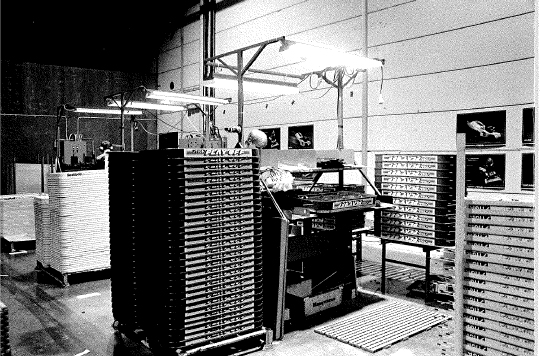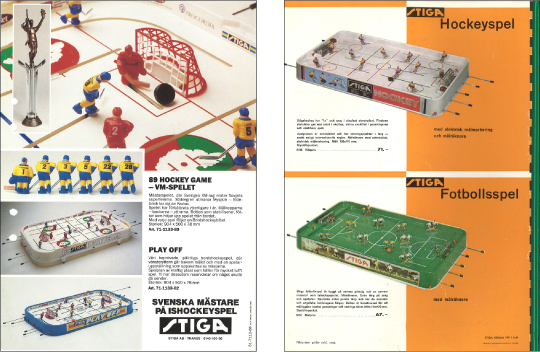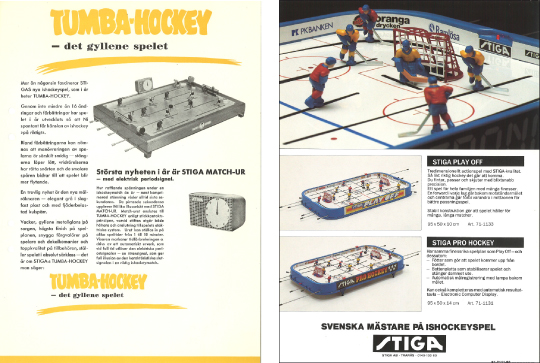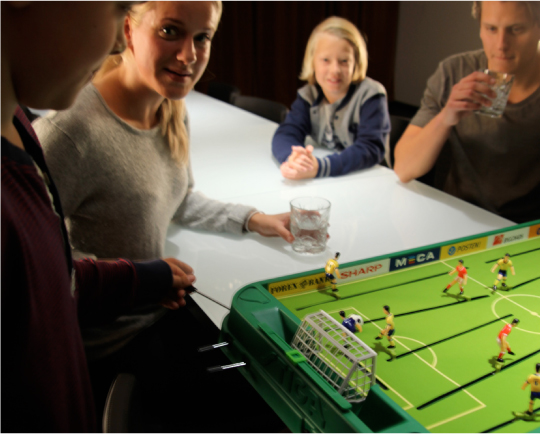-
 English
English

Bengt Bandstigen founded the table tennis company BANDA in 1966, which later became STIGA Sports AB.
In 1983 the company begun to sell STIGA table tennis products and year 2006 we acquired the STIGA Games division to our company.
Today STIGA Sports AB sells table tennis products to more than 100 countries around the world and STIGA is one of the world leading table tennis brands!
STIGA Games has a long history, the first STIGA Table hockey game was out in the market 1957 and more than 5 million games has been sold since then.
The STIGA Snowracer was created 1965 and since then millions of children and adults have enjoyed the fun in the snow every winter.
The latest products that have been introduced are the Badminton and Floor ball assortments.
Today we sell the STIGA Games products to more than 30 countries around the world.

Selling success. Stiga has sold over four million Hockey games since the introduction in the 1950s.
Back in 1957 STIGA released the game “PRO Hockey”. The Swedish ice hockey team “Three Crowns” had won the gold medal at the World Championships. There was an ice hockey euphoria throughout the country, strongly bolstered by the fact that almost every Swedish citizen had followed the tournament not only in the newspapers, but also by watching it with their own eyes in a newly introduced media, the incredible television.
By introducing “PRO Hockey”, STIGA took the experience one step further. STIGA brought the matches to kitchen tables in many Swedish homes. Everybody could pretend they were Sven Tumba Johansson or one of the heroes on the ice. The matches against Russia, Canada and U.S.A. could be repeated over and over again.

Left:Identification. In the late 80s the hand painted players were all named.
Right:Updated. During the 60s the material changed from wood to plastic. The game acquired an ice-alike surface and a rim.
New World Championships could be played. There was the intense fight to score; the clock counted down time, tactics were designed on how to pass from defence to goal scoring forwards. In addition there were the incredible twists and turns when a team recovers, equalises and finally wins. Parents and grandparents played with their children and grandchildren. Anyone not playing became the crowd, applauding, passing comments. The game was alive, almost even more intense than experienced on the television.
“PRO Hockey” became an immediate success. Over 250,000 games were sold during the first two years and, through continual development of the product, became an everlasting hit. Today, 55 years later, it appeals to the customer as much as in the beginning.
Development started almost immediately after introduction by adding a match watch with a match ending signal system. During the 60s the material changed from wood to plastic. The game acquired an ice-alike surface and a rim. The players went from one dimensional to three dimensional, their faces and uniforms painted by hand.
Later the limited direct way of moving was changed. It became possible to move one player behind the goal, which opened new dimensions for tactics and ways of playing. During the 90s licenses were agreed with the National Hockey League in North America and with leagues in several other countries. The agreements opened up new possibilities for the consumers to use players in their own favourite teams, in their own favourite colours.

Left:The beginning. Stiga´s Hockey game became an immediate success, bringing the opportunity to play and experience the World Championships in every family´s kitchen.
Right:Almost reality. The introduction of three dimensional figures makes the game come alive
The continuous development of the product and establishment of new markets has strengthened ice hockey games and made the product appealing to generation after generation. The game of today is also connected to the regular use of electronic devices. Today, youngsters can dial an app in their cell phones which counts the goals, measures the time and follows all the important facts of each single game. The hilarious feeling of playing is constant, the design and accessories follow trends. History and future walk side by side.
No wonder the STIGA Sports game stands up in the competition from computers and mobiles. No wonder STIGA Sports sold over 130 000 ice hockey games worldwide last year. No wonder four million games have been sold since that magical winter back in 1957, the year when Sweden became ice hockey World Champions.

Interactive. Playing Stiga Games is not only fun and thrilling. It also boosts co-operation.
